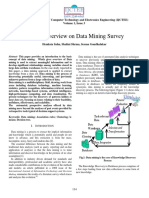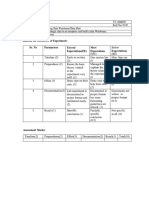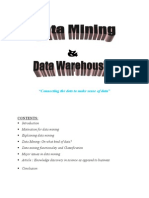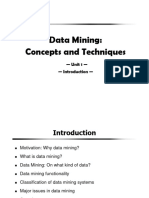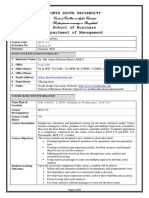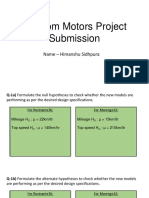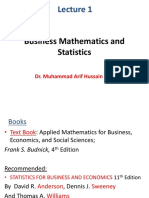0 ratings0% found this document useful (0 votes)
10 viewsData Mining - Extracting Knowledge From Large Datasets
The document discusses data mining and extracting knowledge from large datasets. It describes some risks like finding meaningless patterns and provides examples. Visualization techniques can help discover patterns in data. The document also defines data mining and different types of models that can be extracted from data like predictive, summarization and feature extraction models.
Uploaded by
ralfarywCopyright
© © All Rights Reserved
Available Formats
Download as PDF, TXT or read online on Scribd
0 ratings0% found this document useful (0 votes)
10 viewsData Mining - Extracting Knowledge From Large Datasets
The document discusses data mining and extracting knowledge from large datasets. It describes some risks like finding meaningless patterns and provides examples. Visualization techniques can help discover patterns in data. The document also defines data mining and different types of models that can be extracted from data like predictive, summarization and feature extraction models.
Uploaded by
ralfarywCopyright
© © All Rights Reserved
Available Formats
Download as PDF, TXT or read online on Scribd
You are on page 1/ 1
4/21/24, 7:20 PM Data Mining_ Extracting Knowledge from Large Datasets.
svg
A big data mining risk is discovering
patterns that are meaningless.
Bonferroni's principle: If you look in more
places for interesting patterns than your
data can support, you are bound to find
meaningless patterns. Meaningfulness of Answers
Data mining is the use of efficient
The Rhine Paradox: An example of how techniques for the analysis of very large
not to conduct scientific research, where a collections of data and the extraction of
parapsychologist concluded that telling useful and possibly unexpected patterns
people they have ESP causes them to lose in data.
it.
"Data mining is the analysis of (often large)
observational data sets to find
unsuspected relationships and to
The human eye is a powerful analytical summarize the data in novel ways that are
tool. both understandable and useful to the
data analyst" (Hand, Mannila, Smyth).
Visualizing the data properly can help
discover patterns. Visualization: Post-processing What is Data Mining?
"Data mining is the discovery of models for
data" (Rajaraman, Ullman).
There are multiple visualization
techniques, such as scatter plots, contour Models that explain the data (e.g., a single
plots, and histograms. function)
Models that predict the future data
instances
Frequency and Mode: Useful for
categorical data. We can have the following types of models:
Models that summarize the data
Percentiles, Mean, and Median: Measures
of location for continuous data. Summary Statistics: Models that extract the most prominent
features of the data
Range and Variance: Measures of spread
for continuous data.
Scientific data from different disciplines
An important distribution that (weather, astronomy, physics, biological
characterizes many quantities. microarrays, genomics)
Normal Distribution: Exploratory Data Analysis
Fully characterized by the mean and Huge text collections (the web, scientific
standard deviation. articles, news, tweets, Facebook postings)
Huge amounts of complex data generated
Many real-world phenomena, such as from multiple sources and interconnected Transaction data (retail store records,
word frequencies, follow power-law in different ways, such as: credit card records)
distributions.
Behavioral data (mobile phone data, query
Detected by a linear relationship in the log- logs, browsing behavior, ad clicks)
log space. Power-law Distributions:
Networked data (the web, social networks,
Examples include incoming/outgoing links IM networks, email networks, biological
of web pages, number of friends in social networks)
networks, file sizes, city sizes, income
distribution, and product/movie popularity.
Why Do We Need Data Mining? These data types can be combined in
many ways (e.g., Facebook has a network,
text, images, user behavior, ad
transactions).
Perform simple processing to "normalize"
the data (remove punctuation, make into
lowercase, clear white spaces, etc.). We need to analyze this data to extract
knowledge for commercial or scientific
purposes.
Break into words and keep the most
popular words. First Cut:
Data Mining: Our solutions should scale to the size of
the data.
The most frequent words are often stop
words. Extracting
Remove stop words using a pre-defined Knowledge from Preprocessing: Real data is noisy, Techniques: Sampling, dimensionality
stop word list. incomplete, and inconsistent. Data
Data Preprocessing
Large Datasets cleaning is required to make sense of the
reduction, feature selection.
Second Cut: data.
The remaining words are more informative This is often the most important step for
for describing the restaurants. the analysis.
Term Frequency (TF): The number of times Statistical analysis of importance
a word appears in a document. Mining is not the only step in the analysis Post-processing: Make the data actionable
The Data Analysis Pipeline process: and useful to the user.
Visualization
Inverse Document Frequency (IDF): A
measure of the uniqueness of a word
across documents. TF-IDF: Pre- and post-processing are often data
mining tasks as well.
TF-IDF = TF * IDF: Combines term
frequency and inverse document
frequency to identify the most important
Noise and outliers
words.
Data Quality Examples of data quality problems: Missing values
Sample review text from Yelp and Duplicate data
Foursquare. Example Data
Sampling is the main technique employed
Suppose we want to mine the for data selection.
comments/reviews of people on Yelp and
Foursquare. It is often used for both the preliminary
investigation of the data and the final data
Today, there is an abundance of data analysis.
online (Facebook, Twitter, Wikipedia, the
web, etc.). The key principle for effective sampling is
that using a sample will work almost as
We can extract interesting information well as using the entire data sets if the
sample is representative.
from this data, but first we need to collect it. A Detailed Data Preprocessing
Data Collection: Example
Use customized crawlers, public APIs, and A sample is representative if it has
additional cleaning/processing to parse approximately the same property (of
out the useful parts. interest) as the original set of data.
There is an equal probability of selecting
Respect crawling etiquette.
any particular item.
Collect all reviews for the top-10 most Sampling
reviewed restaurants in New York on Yelp. Sampling with replacement: Objects are
not removed from the population as they
Mining Task: Simple Random Sampling: are selected.
Find a few terms that best describe the
restaurants.
Sampling without replacement: As each
item is selected, it is removed from the
Types of Sampling population.
You have N integers and want to sample
one integer uniformly at random. Split the data into several groups, then
draw random samples from each group.
The integers are coming in a stream: you Stratified Sampling:
do not know the size of the stream in Ensures that both groups are represented.
advance, and there is not enough memory
A Data Mining Challenge:
to store the stream. Reservoir Sampling
The sample size necessary depends on the
specific application and the desired level
With probability 1/n, select the nth item of of accuracy.
the stream and replace the previous choice.
Sample Size Larger samples generally provide more
This ensures that every item has The solution is Reservoir Sampling: accurate results, but also require more
probability 1/N to be selected after N items resources.
have been read.
file:///home/kali/Documents/Data Mining_ Extracting Knowledge from Large Datasets.svg 1/1
You might also like
- (Haskins) Practical Guide To Critical Thinking PDF100% (2)(Haskins) Practical Guide To Critical Thinking PDF14 pages
- A Brief Overview On Data Mining Survey PDFNo ratings yetA Brief Overview On Data Mining Survey PDF8 pages
- Insert Your Titles and Guide Name: International Research Journal of Engineering and Technology (IRJET)No ratings yetInsert Your Titles and Guide Name: International Research Journal of Engineering and Technology (IRJET)8 pages
- "Connecting The Dots To Make Sense of Data": ContentsNo ratings yet"Connecting The Dots To Make Sense of Data": Contents14 pages
- Data Science Terminology Flashcards - Quizlet100% (1)Data Science Terminology Flashcards - Quizlet15 pages
- An Intelligent Approach of Rough Set in Knowledge Discovery DatabasesNo ratings yetAn Intelligent Approach of Rough Set in Knowledge Discovery Databases4 pages
- Multidimensional Data Analysis, Data Mining and Knowledge DiscoveryNo ratings yetMultidimensional Data Analysis, Data Mining and Knowledge Discovery6 pages
- Visualization of High Dimensional Scientific DataNo ratings yetVisualization of High Dimensional Scientific Data105 pages
- An Analysis of Outlier Detection Through Clustering MethodNo ratings yetAn Analysis of Outlier Detection Through Clustering Method6 pages
- Scalable Pattern Recognition For Large-Scale Scientific Data MiningNo ratings yetScalable Pattern Recognition For Large-Scale Scientific Data Mining14 pages
- Hand2007 - Article - Principles Ofs DataMiningNo ratings yetHand2007 - Article - Principles Ofs DataMining2 pages
- Connecting The Dots To Make Sense of DataNo ratings yetConnecting The Dots To Make Sense of Data8 pages
- Fundamental Data Mining in Institutional Research WorkshopNo ratings yetFundamental Data Mining in Institutional Research Workshop68 pages
- Big Data Processing Technologies in Distributed inNo ratings yetBig Data Processing Technologies in Distributed in6 pages
- Data-Mining and Knowledge Discovery, Neural Networks inNo ratings yetData-Mining and Knowledge Discovery, Neural Networks in15 pages
- Research of Data Mining Based On Neural Networks: Xianjun NiNo ratings yetResearch of Data Mining Based On Neural Networks: Xianjun Ni4 pages
- Insight Into Theoretical and Applied Informatics I... - (2.2.4 Data Mining)No ratings yetInsight Into Theoretical and Applied Informatics I... - (2.2.4 Data Mining)5 pages
- Data Mining (The Analysis Step of The "Knowledge Discovery in Databases" Process, or KDD)No ratings yetData Mining (The Analysis Step of The "Knowledge Discovery in Databases" Process, or KDD)1 page
- Data Mining and Data Warehouse BY: Dept. of Computer Science EngineeringNo ratings yetData Mining and Data Warehouse BY: Dept. of Computer Science Engineering10 pages
- Data Science and its role in data analyticsNo ratings yetData Science and its role in data analytics23 pages
- Data Mining: Department of Computer Science & Engineering Jamia Hamdard, New DelhiNo ratings yetData Mining: Department of Computer Science & Engineering Jamia Hamdard, New Delhi43 pages
- World's Largest Science, Technology & Medicine Open Access Book PublisherNo ratings yetWorld's Largest Science, Technology & Medicine Open Access Book Publisher26 pages
- Data Mining: Department of Computer Science & Engineering Jamia Hamdard, New DelhiNo ratings yetData Mining: Department of Computer Science & Engineering Jamia Hamdard, New Delhi43 pages
- Knowledge Discovery in Databases (KDD) : An OverviewNo ratings yetKnowledge Discovery in Databases (KDD) : An Overview4 pages
- Data Mining Using Evolutionary Algorit Data Mining Using Evolutionary Algorithm HMNo ratings yetData Mining Using Evolutionary Algorit Data Mining Using Evolutionary Algorithm HM11 pages
- 4 - A Survey On Contribution of Data Mining - B LavanyaNo ratings yet4 - A Survey On Contribution of Data Mining - B Lavanya7 pages
- Identification of Missing Person Using CNNNo ratings yetIdentification of Missing Person Using CNN5 pages
- Neural Networks for Beginners: Introduction to Machine Learning and Deep LearningFrom EverandNeural Networks for Beginners: Introduction to Machine Learning and Deep LearningNo ratings yet
- Multiple Regression Analysis, The Problem of EstimationNo ratings yetMultiple Regression Analysis, The Problem of Estimation53 pages
- BPBR7103 Business Research Assignment Jan 2020No ratings yetBPBR7103 Business Research Assignment Jan 202025 pages
- Lecture 2 Merits and Limitations of Inductive and Deductive MethodsNo ratings yetLecture 2 Merits and Limitations of Inductive and Deductive Methods4 pages
- Stata Item Response Theory Reference Manual: Release 17No ratings yetStata Item Response Theory Reference Manual: Release 17257 pages
- The Effect of Road Safety Education On Knowledge ANo ratings yetThe Effect of Road Safety Education On Knowledge A7 pages
- Solutions for Using and Understanding Mathematics 8th Edition by BennettNo ratings yetSolutions for Using and Understanding Mathematics 8th Edition by Bennett31 pages
- 08 - Mahalik - Masculinity and Perceived Normative Health Behaviors As Predictors of Men Heatlh BehaviorsNo ratings yet08 - Mahalik - Masculinity and Perceived Normative Health Behaviors As Predictors of Men Heatlh Behaviors9 pages
- CSDS 440: Machine Learning: Soumya Ray (No ratings yetCSDS 440: Machine Learning: Soumya Ray (31 pages
- Hypothesis Testing by Example Hands On Approach Using RNo ratings yetHypothesis Testing by Example Hands On Approach Using R39 pages
- Packag Technol Sci - 2022 - Berumen - Interactions of Fast Moving Consumer Goods in Cooking Insights From A QuantitativeNo ratings yetPackag Technol Sci - 2022 - Berumen - Interactions of Fast Moving Consumer Goods in Cooking Insights From A Quantitative15 pages
- Construction of Decision Tree Attribute Selection MeasuresNo ratings yetConstruction of Decision Tree Attribute Selection Measures5 pages
- WoE Methopd For Landslide Susceptibility MAp in Tandikek and Damarbancah - IJSRNo ratings yetWoE Methopd For Landslide Susceptibility MAp in Tandikek and Damarbancah - IJSR8 pages
- Sip Project Report Guidelines: Progressive Education Society's Modern College of Engineering, Pune - 5No ratings yetSip Project Report Guidelines: Progressive Education Society's Modern College of Engineering, Pune - 511 pages
- Business Mathematics and Statistics: Dr. Muhammad Arif HussainNo ratings yetBusiness Mathematics and Statistics: Dr. Muhammad Arif Hussain39 pages

